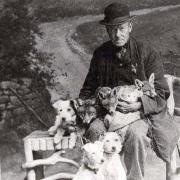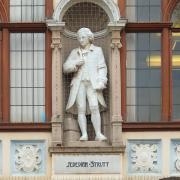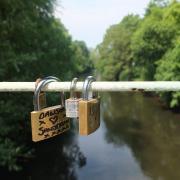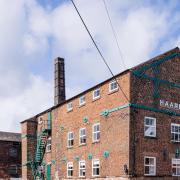Behind the Throne, the most recent book written by the prolific Derbyshire-born author Adrian Tinniswood, is a fascinating and gossipy account of the lives of people employed ‘to smooth the path through life of English sovereigns from Elizabeth I to our present Queen’.

According to Adrian: ‘Kings and Queens and their families were, and still are, entitled by their position to a certain level of comfort. Sovereigns don’t cook, don’t dress themselves, pour themselves a drink or make their own bed.’
But the duties of some courtiers in the past went well beyond the provision of comfort. Elizabeth I employed a ‘fool’ as a plaything and confidante. James I had a courtier whose job sometimes entailed telling bawdy tales for the King’s amusement, while he and another courtier were required to organise dances and horseplay, often involving several members of the royal household riding round on each other’s backs in imitation jousts. George III kept an orchestra of 22 musicians who were required to perform each evening at Windsor from 8pm to 10pm, and Queen Victoria employed pipers to wake her each morning when she stayed at Balmoral.
Adrian has written 14 books covering social and architectural history, but he has clearly enjoyed adding this latest offering to his impressive portfolio, not least because it satisfies what the critic Rachel Cooke has called the author’s ‘boundless taste for gossip’. When I chatted to Adrian at the Buxton Book Weekend last November, he admitted that he has always loved passing on stories.
Brought up in the Derbyshire village of Alvaston, Adrian went to secondary school in the Derby suburb of Spondon, before going to Southampton University to read English and Philosophy. After graduating, he studied for an MPhil at Leicester University, which involved writing a thesis about ‘The Minor Poets of the 1890s’. Whilst agreeing that this was a rather obsure area of study, Adrian told me he had been fascinated to find that gossip circulating in the 1890s had suggested that John Gray, one of the poets he was studying, was the model for Oscar Wilde’s fictional character Dorian Gray.
While he was working on his thesis, Adrian landed a job as a guide and researcher at Sudbury Hall, a role which turned out to be influential in determining his direction as a writer.
He said: ‘Sudbury was one of the first National Trust properties in the country to design activities to appeal to young visitors. These include a children’s museum where young visitors can experience being taught in a Victorian classroom with a strict regime. As one of my duties, I was asked on some occasions to play the part of a cane-wielding schoolteacher. I was also required to produce educational material, a task that helped to launch my subsequent career as a writer who tries to make sense of the past for the ordinary reader.’
Inspired by his time at Sudbury and his visits to the many other country houses in Derbyshire, Adrian wrote Historic Country Houses of the National Trust. This was followed by Country Houses from the Air and a succession of other books about grand estates and the people who lived there. His best-known book is The Long Weekend, which describes life in country houses between the two world wars. It was named the ‘Daily Telegraph Book of the Year for 2016’ and became a best-seller.
Adrian, who was awarded the OBE for Services to Heritage in 2013, now lives near Bath and is a consultant to the National Trust, a Visiting Fellow in Heritage and History at Bath Spa University and a Senior Research Fellow in History at the University of Buckingham. Although he is happy to take on these various roles, Adrian insists that he is primarily a writer.
Research into the workings of royal households over the centuries has given Adrian some wonderful material as a writer, not least from his discoveries about the excessive number of people working in Queen Victoria’s household, which included 22 people being employed to fill the Queen’s coal scuttle. When ministers complained that her expenses were exceeding limits set by the Treasury, she responded by having fewer varieties of bread at breakfast and replacing toilet paper at Windsor with newspaper squares. However, the Queen refused to cut down on the number of residences she used. The increasing amounts of time she spent at Osborne House, the Italianate palace on the Isle of Wight, meant that ministers had to make sea crossings to ask her to sign official papers.
As Adrian reminds readers, Queen Victoria was also in the habit of giving jobs to her personal favourites. John Brown, a stable boy at Balmoral, was appointed by the Queen as her ‘personal servant for out-of-doors’ and was even allowed to sit alongside her at the Highland Games. Abdul Karim, an Indian who had been employed to wait on visiting Indian dignitaries, was appointed by the Queen as her ‘Indian Secretary’. When it was discovered that Victoria had been showing Karim sensitive letters and dispatches, security issues were raised. And security concerns of a different kind were highlighted by the ease with which a builder’s assistant called Edward Jones had been able to break into the royal apartments at Buckingham Palace on three occasions. One wag said that the intruder must have been descended from ‘In-I-go Jones’ – a reference to Inigo Jones, the celebrated architect who had designed the Banqueting House in Whitehall.
A breach of confidentiality became a concern for the Royal Family in 1949 when Marion Crawford published her memoirs about her 16 years as a governess to Princesses Elizabeth and Margaret. Shortly after the publication of The Little Princesses, Gabriel Tschumi published his recollection of life as a royal chef but, as Adrian points out, his descriptions of the contents of Queen Mary’s breakfast tray were trivial when compared with the stories that began to emerge from members of the royal household in the early 1990s about the troubled marriage of Prince Charles and Princess Diana. The accounts were so numerous and so conflicting that Charles and Diana decided to give television interviews to air their own versions of the marriage.
The fact that today’s young royals are prepared to speak openly about their feelings and anxieties without any prompting from stories in the press indicates how much the conduct of the Royal Family has changed. The structure of the royal household has also altered radically from the days when it was a vast machine designed to support the sovereign while simultaneously confirming his or her status. However, many traditional roles at court were retained long after their original function had become obsolete. For example, a Keeper of the Royal Tennis Courts was still employed at a time when there were no tennis courts in any of the royal estates.
Adrian says: ‘The number of people employed at court has been slimmed down from the 2,000 people employed by Charles I to the present staff of 1,200. Although Elizabeth II’s household is modern and streamlined, even having its own website and Instagram and Twitter accounts, traditional roles have not been eliminated entirely. There are still Women of the Bedchamber, a Keeper of the Privy Purse and a Mistress of the Robes, just as there were in Elizabeth I’s time.’
Behind the Throne by Adrian Tinniswood is published by Jonathan Cape



























